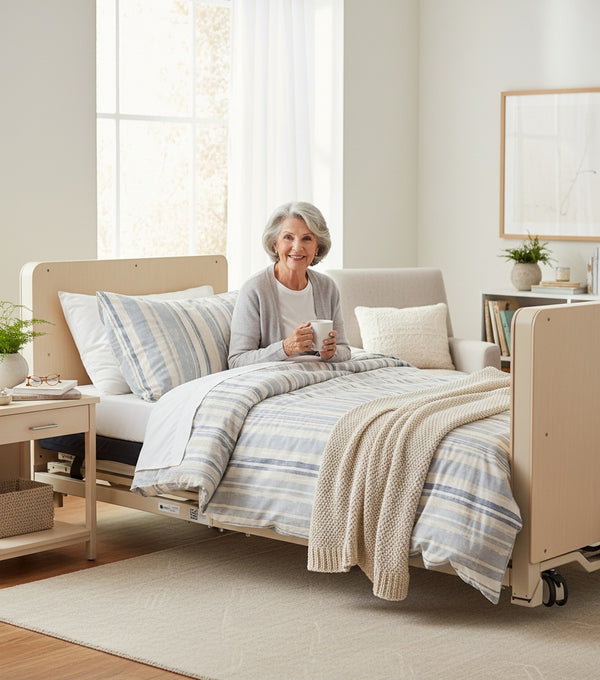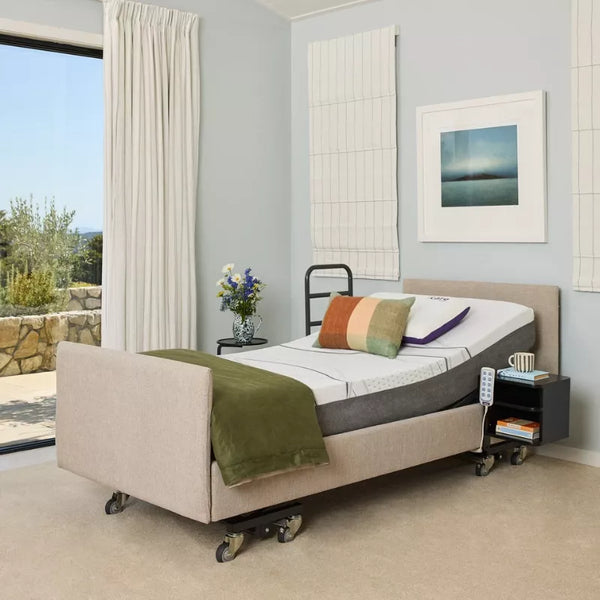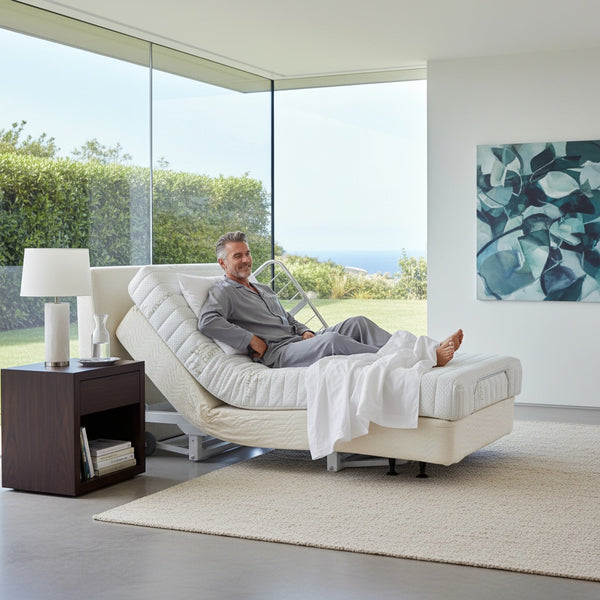
Who Actually Needs a Trendelenburg Bed? The Only Guide That Matters
ULB 3.9 Standard (Trendelenburg)

Icare IC333 (Trendelenburg)
Supernal 5 by Transfer Master (Trendelenburg)
New Valiant by Transfer Master (Trendelenburg)
Medacure LX-Bari w/ Linak Motor (Trendelenburg)
Look at these 2 visuals to get a better idea: Trendelenburg (feet up, head down) = blood flows to brain and heart.
Trendelenburg (feet up, head down) = blood flows to brain and heart.
 Reverse Trendelenburg (head up, feet down) = keeps acid in stomach, lungs get room
Reverse Trendelenburg (head up, feet down) = keeps acid in stomach, lungs get room
This isn't about getting comfortable while watching TV. These are prescription-grade positioning tools designed for specific medical conditions:
- Poor circulation following surgery or for patients with cardiac and vascular issues—Trendelenburg promotes blood flow back to the core and helps prevent pooling, dangerous swelling, and orthostatic hypotension.
- Respiratory complications—Reverse Trendelenburg is frequently prescribed for cardiac and pulmonary patients, particularly bariatrics, because it opens up the chest cavity and allows proper lung expansion.
- Pressure ulcers and bedsores—True Trendelenburg positioning enables the frequent position changes needed to maintain tissue perfusion, which matters far more than basic leg elevation.
- Neurological and critical recovery cases—Physicians may order Trendelenburg for spinal injury patients, post-stroke survivors, or those requiring advanced wound care protocols.
When a doctor, nurse, or physical therapist specifically mentions "Trendelenburg" or "reverse Trendelenburg" as part of your care plan, you need a bed that can perform these functions safely. If it wasn't mentioned in your medical guidance, think carefully about whether you need these specialized features.
The Reality of Shopping for Trendelenburg Beds
- Not all "hospital beds" deliver true Trendelenburg—Some manufacturers use the term for SEO purposes despite lacking the motor strength, safety mechanisms, or tilt range required for actual clinical positioning. Shop Trendelnburg hospital beds at Medshop Direct for the actual clinical grade Trendelenburg beds.
- The terminology gets confusing fast—You'll run into misspellings like "trendelburg" and "trendelenberg," plus vague phrases like "adjustable hospital bed with tilt." A lot of budget models offer basic articulation without true full-bed tilting capability.
- Feature mismatch causes real problems—Buy a contour bed or simple leg-lift model when you actually need clinical-grade Trendelenburg, and you're looking at inadequate care and potential insurance headaches.
How to Know If You Really Need a Trendelenburg Bed
- Check your discharge papers, DME orders, or care instructions—Did a medical provider specifically document "Trendelenburg" or "reverse Trendelenburg"?
- Consider the diagnosis—Are you or your loved one a bariatric patient, dealing with chronic edema, or at risk for aspiration or pneumonia?
- Think about positioning needs—Is there a clinical reason to keep the head elevated above the feet for cardiac support, reflux management, or respiratory issues?
- Evaluate what you've already tried—Have standard positioning methods failed to manage pressure, pain, or oxygen levels adequately?
When these criteria match your situation, a standard adjustable base or semi-electric bed probably won't cut it. You need the real thing.
The Medical Conditions That Actually Require Trendelenburg Positioning
Let's get specific about when doctors actually prescribe these beds, because "circulation issues" doesn't tell the whole story.
Reverse Trendelenburg for GERD and Severe Acid Reflux
When you've got chronic GERD, nighttime aspiration risk, or a hiatal hernia that won't quit, sleeping flat becomes dangerous. Reverse Trendelenburg keeps stomach acid where it belongs—down in the stomach, not creeping up into your esophagus or lungs. Shop Hospital Beds for Acid Reflux and GERD.
This isn't the same as propping yourself up on pillows. It's a controlled 10-15 degree incline of the entire sleeping surface that prevents reflux without creating pressure points or causing you to slide down during the night. Pulmonologists and gastroenterologists routinely prescribe this positioning for patients who've had failed fundoplications, chronic aspiration pneumonia, or Barrett's esophagus. The American College of Gastroenterology recognizes head-of-bed elevation as a key non-pharmacological intervention for GERD management.
Standard Trendelenburg for Hypotension and Shock Prevention
Head-down positioning increases venous return to the heart—it's basic physiology. For patients with severe orthostatic hypotension, autonomic dysfunction (like POTS), or those recovering from hypovolemic episodes, getting blood flow back to the brain quickly can prevent syncope and falls.
There's a reason paramedics have used Trendelenburg positioning in the field for decades when someone's pressure is tanking. While recent research has refined exactly when and how to use it, the principle remains: when you need to redistribute blood volume fast, gravity is your friend.
Post-Surgical Venous Return and DVT Prevention
After major abdominal surgery, pelvic procedures, or vascular interventions, surgeons want legs elevated above the heart to reduce venous stasis and deep vein thrombosis risk. But this isn't just about "legs up on a pillow"—the entire body needs proper positioning to encourage flow without creating shear forces that can damage healing tissue or surgical sites.
According to guidelines from the Society for Vascular Surgery, proper positioning plays a crucial role in post-operative DVT prophylaxis, especially for patients who can't immediately ambulate.
Bariatric Respiratory Distress
For patients over 350-400 lbs, lying flat can literally restrict breathing. The weight of the abdomen compresses the diaphragm and reduces functional residual capacity. Reverse Trendelenburg positioning is often the difference between sleeping through the night and waking up gasping for air.
This is why bariatric ICUs and post-surgical units keep beds in reverse Trendelenburg as standard protocol. The Obesity Medicine Association and bariatric surgery programs across the country recognize that proper positioning isn't optional—it's a basic safety requirement for this patient population.
If your doctor mentioned any of these diagnoses—GERD with aspiration risk, orthostatic hypotension, post-op DVT prophylaxis, or bariatric respiratory compromise—you're not shopping for a luxury adjustable base. You're shopping for a medical device that needs to work every single night, like the cost effective ULB 3.9 by Medacure, or the LX-Bari for overweight individuals by the same manufacturer. Both hospital beds use the whisper quiet Linak motor.
Call us 833-499-4450 if you need support, email support@medshopdirect.com if you prefer to contact us via email. Shop all Hospital Beds for Sale, return to our home page or shop for more hospital beds with Trendelenburg positions.
Frequently Asked, Hardball Questions
Will Medicare or insurance pay for this?
Only if it’s medically necessary AND the Trendelenburg function is documented by a provider. For home use without Rx? Plan to pay out of pocket.
What’s the difference between Trendelenburg and just “leg elevation”?
Leg elevation raises legs. Trendelenburg tilts your entire body—used for legitimate medical scenarios, not just comfort.
Is it hard to operate these beds?
All models listed are fully electric. If you can use a TV remote, you’re set.
Call 833-499-4450 if you have any questions and we are more than Happy to assist you.



